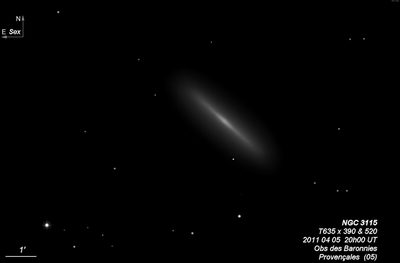Spindle Galaxy
Spindle Galaxy

William Herschel discovered NGC 3115 = H I-163 = h668 = h3223 on 22 Feb 1787 (sweep 704) and recorded "eB, cL, mE 45° sp to nf. The bright part about 2' long with vF branches extending in all, to 4 or 5'." On 14 Mar 1828 (sweep 136), John Herschel wrote, "vB; L; mE; vsmbM; almost to a nucl; 3' l, 30" br. With 12-inches aperture, its nucleus is rather speckled; with 6-inch it is barely discernible as a neb."
NGC 3115 was first observed by Lord Rosse on 11 Mar 1848 (one of the earliest observations). In 1861, Lord Rosse's observer questioned if "Is Nucl. resolvable and oblong?"
200/250mm - 8" (3/24/84): very bright, high surface brightness, very bright core.
300/350mm - 13.1" (3/24/84): stunning edge-on, very bright, small very bright core.
400/500mm - 17.5" (1/31/87): very bright, fairly large, edge-on spindle 3:1 SW-NE, 5.5'x1.8'. Unusually high surface brightness, bright core, stellar nucleus. A mag 12.5 star is 3.2' S of center and a mag 10.5 star is 8' E. MCG -01-26-021 lies 17' SSE.
900/1200mm - 48" (2/19/12): this showpiece galaxy was stunning at 287x and 375x, with a very high surface brightness halo, ~5.5'x2', which is punctuated by a brilliant, nearly stellar nucleus. The nucleus is centered within an extremely bright, very flattened core extending 1'-1.5'. This dazzling streak dims slightly outside the central region but stretches at least 2.5' along the major axis with no breaks or significant drops in surface brightness. The view of this thin, super-luminous central disc bisecting most of the outer, elongated halo was a unique sight.
UGCA 200, a faint dwarf galaxy, lies 5.7' SE. At 375x it appeared as a faint low surface brightness patch with averted vision, slightly elongated NNW-SSE, with no central concentration. The galaxy is situated within a triangle formed by a mag 11.2 star 1.7' SE, a mag 15.3 star 1.5' NW and a mag 13.8 star 2' ENE.
Notes by Steve Gottlieb